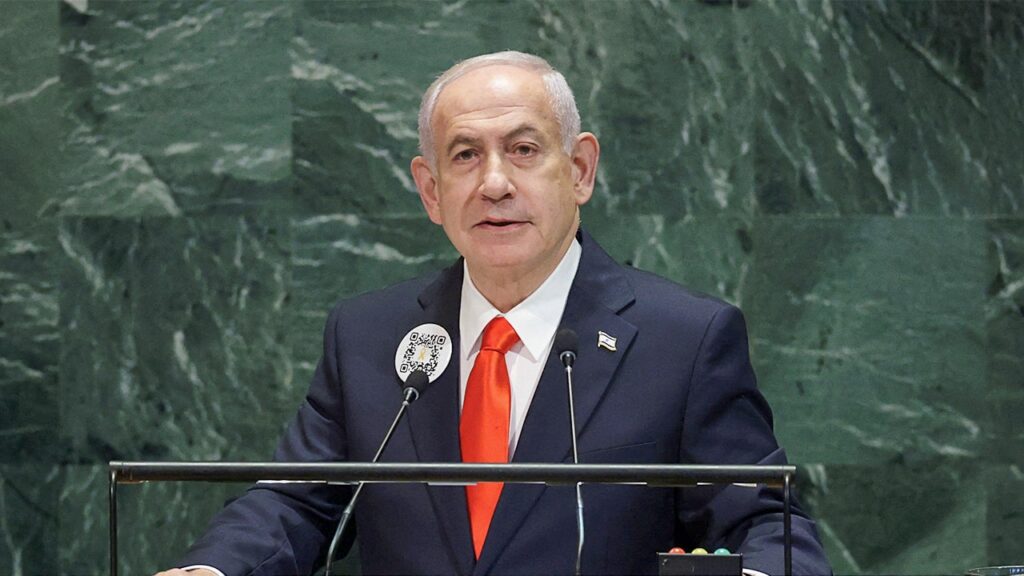Israeli Prime Minister Benjamin Netanyahu has issued a call to neighboring nations, urging them to join Israel in the effort to eradicate Hamas from the region. This appeal follows the endorsement of former President Donald Trump‘s peace plan for Gaza by the United Nations Security Council (UNSC). The resolution aims to bring an end to the ongoing conflict and establishes a framework for international stabilization in the area. Netanyahu’s remarks emphasize Israel’s commitment to peace and stability, urging collective action from regional partners.
| Article Subheadings |
|---|
| 1) Netanyahu’s Invitation to Neighbors |
| 2) UNSC Endorsement of Trump’s Peace Plan |
| 3) The Situation in Gaza |
| 4) Potential Impacts of the Peace Plan |
| 5) Expanding the Abraham Accords |
Netanyahu’s Invitation to Neighbors
On September 26, 2025, during an address to the UN, Benjamin Netanyahu emphasized the importance of cooperation among regional nations to eliminate Hamas, describing the need for solidarity in achieving peace. His office reflected this sentiment, stating, “Israel extends its hand in peace and prosperity to all of our neighbors…” This declaration aims to foster relationships that could lead to stability in the region, showcasing Israel’s readiness for diplomatic engagement with its neighbors. Netanyahu’s invitation suggests a willingness to collaborate not just on military fronts but to seek a path toward lasting international relationships.
UNSC Endorsement of Trump’s Peace Plan
The UNSC’s endorsement of Trump’s peace plan marks a significant moment in Middle East diplomacy. On a recent Monday, the resolution received overwhelming support with a 14-0 vote, alongside two abstentions, including Russia. The resolution aims to cease hostilities in Gaza and deploy an international stabilization force to assist in the region’s recovery. During his address, Waltz, a key figure in this dialogue, described Gaza as a “hell on earth,” underscoring the critical condition resulting from years of conflict. He stated, “Voting yes today isn’t just endorsing a plan; it’s affirming our shared humanity. A vote against this resolution is a vote to return to war.”
The Situation in Gaza
The humanitarian situation in Gaza has reached alarming levels, prompting international concern. With schools reduced to rubble and essential infrastructure destroyed, the region mirrors a desolate landscape of despair and desperation. Netanyahu’s government emphasizes that the peace plan includes strict conditions for Gaza’s demilitarization and a commitment to disarmament. This is seen as a necessary step to prevent future conflicts and ensure long-lasting peace. Notably, Israel also called for the release of remaining deceased hostages, highlighting the personal tragedies intertwined within the broader conflict. This situation necessitates urgent and effective international intervention to restore hope and stability to the people of Gaza.
Potential Impacts of the Peace Plan
Netanyahu’s office confidently praised the UNSC’s decision, asserting that the implementation of the peace plan could lead to peace and prosperity in the region. With an emphasis on demilitarization and deradicalization, the plan seeks to lay the groundwork for a more stable future not only for Israel but also for its neighbors. Israeli officials are aware that successful implementation will depend on cooperation and adherence from all parties involved, including Hamas, a pivotal player in the area’s political landscape. Therefore, the focus is on ensuring that the peace process effectively addresses the causes of unrest while promoting collaboration among nations for a unified goal.
Expanding the Abraham Accords
Furthermore, in addition to addressing immediate conflicts, Netanyahu expressed hopes that the current peace plan could invigorate the principles behind the Abraham Accords, which normalized relations between Israel and several Arab nations, including the United Arab Emirates, Bahrain, Sudan, and Morocco. This expansion is envisioned as a way to strengthen diplomatic ties and promote integration within the region, aligning with Trump‘s vision of a cooperative Middle East. The potential for peace, coupled with economic collaboration, could transform diplomatic relations into lasting alliances, fostering mutual benefits among nations interested in stability and growth.
| No. | Key Points |
|---|---|
| 1 | Netanyahu calls for regional cooperation to expel Hamas. |
| 2 | UNSC endorses Trump’s peace plan with a 14-0 vote. |
| 3 | Gaza’s humanitarian crisis demands immediate attention and action. |
| 4 | The peace plan focuses on demilitarization and disarmament of Gaza. |
| 5 | Expansion of the Abraham Accords could reshape regional relations. |
Summary
The discourse surrounding peace in the Middle East has taken a pivotal turn with Prime Minister Benjamin Netanyahu advocating for a cooperative approach aimed at dismantling threats exemplified by Hamas. In the backdrop of the UNSC’s endorsement of Donald Trump’s peace plan, the region stands on the precipice of potential transformation. The unfolding events highlight the intricate relationship between immediate conflict resolution and long-term diplomatic engagements that could usher in an era of stability and collaboration.
Frequently Asked Questions
Question: What does Netanyahu’s call for cooperation entail?
Netanyahu’s plea involves encouraging neighboring countries to join Israel in efforts to remove Hamas from the region and promote stability through enhanced diplomatic relations.
Question: How does the UNSC’s resolution impact the peace process?
The UNSC’s resolution not only endorses Trump’s peace plan but also serves as a critical validation for international involvement aimed at stabilizing Gaza and ending its humanitarian crisis.
Question: What is the significance of the Abraham Accords in this context?
The Abraham Accords represent a framework for normalized relations between Israel and several Arab nations, promoting economic collaboration and peaceful coexistence, which Netanyahu hopes to expand through the current peace efforts.


